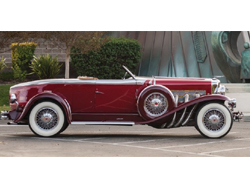1929 Duesenberg Model J
 David Gray’s family managed to parlay a $10,500 investment in Ford stock into a $36 million windfall, including $10 million in dividends paid over 16 years and a stock buyback, in 1919, of $26 million. That afforded the family a certain lifestyle, and no one would have raised an eyebrow when David took delivery of a 1929 Murphy-bodied Duesenberg Model J disappearing top torpedo roadster. In late January, the Duesy that Ford bought, still wearing its original body, mounted on the original frame, will cross the block in Arizona as part of the RM Sotheby’s sale.
David Gray’s family managed to parlay a $10,500 investment in Ford stock into a $36 million windfall, including $10 million in dividends paid over 16 years and a stock buyback, in 1919, of $26 million. That afforded the family a certain lifestyle, and no one would have raised an eyebrow when David took delivery of a 1929 Murphy-bodied Duesenberg Model J disappearing top torpedo roadster. In late January, the Duesy that Ford bought, still wearing its original body, mounted on the original frame, will cross the block in Arizona as part of the RM Sotheby’s sale.
John Gray, David’s father, was a man of many business interests, ranging from toys to candy to banking. In 1903, John was approached by his nephew, Alexander Malcolmson, to invest in a struggling Ford Motor Company, which was seeking funding to pay a debt owed to John and Horace Dodge. As a prominent member of the Detroit business community, having Gray on board would attract other investors, and the plan worked. The Ford Motor Company was incorporated on June 16, 1903, with John Gray elected its first president. He’d serve in this role until his death from a heart attack in 1906.
Henry Ford then assumed the role of president, but the Gray family retained possession of their Ford shares until 1919, when Henry Ford paid a then near-unimaginable sum of $26 million to buy back the family’s shares. David Gray had already established himself as a sportsman and car collector with a penchant for early Packards, and the money allowed him to further indulge in his hobbies.
Chassis 2199 was originally built with engine J-178 and fitted with Murphy disappearing top torpedo roadster body 876. Finished in silver with blue fenders, the car was shown at the 1929 Chicago Auto Salon, then sold to David Gray shortly after. Some sources say the car was originally equipped with the rumble seat it carries today (suitable for a single passenger, owing to the torpedo body’s narrow rear) and period photos reportedly confirm this, but others say the car was assembled without. In either case, the short-wheelbase Duesenberg must have been a joy to drive on the roads near David’s Santa Barbara, California, home.
In 1933, David reportedly sold the car for the sum of $4,000 to William McDuffie, who later sold the car to a Buick dealer. The next owner of record was William Hunter, a Duesenberg collector who owned J-178, J-190, J-420 and J-444, and was said to mix and match parts between the cars as needed. While the car passed through several more owners during the Second World War, it managed to survive without being scrapped, and was again offered for sale, this time without an engine or wheels, circa 1947.
Thus begins perhaps the oddest chapter in 2199’s life. Fitted with a Buick engine, the car passed through a few more caretakers, the most notable of which may have been Robert J. Gottlieb, a Motor Trend columnist and Beverly Hills attorney. In 1951, the modified Duesenberg was acquired by marque collector William Coverdale, who pulled the Buick engine and replaced it with J-414, taken from Duesenberg chassis 2430. That chassis, and its seven-passenger limousine body, was passed along to another Duesenberg collector.
Coverdale kept the car until 1985, when it was sold to the Rick Carrol Collection, albeit briefly. It passed through one more owner before landing with the Blackhawk Collection, where it was treated to a through restoration in the early 1990s. The original fenders were duplicated during this effort, and both the side exhausts and chrome radiator shell were added.
Despite the numerous owners over the years, chassis 2199 reportedly shows less than 18,000 miles on the odometer, and is said to be one of four disappearing top convertible coupes known to retain its original body. RM Sotheby’s is predicting a selling price between $3 million and $3.5 million.